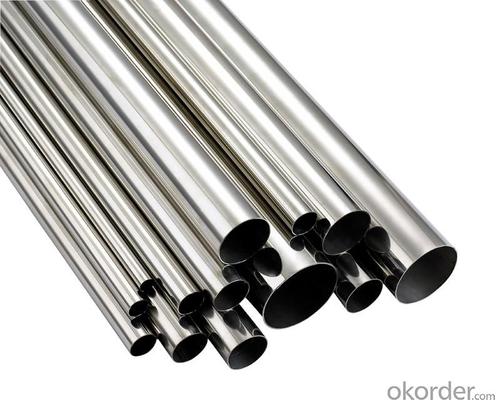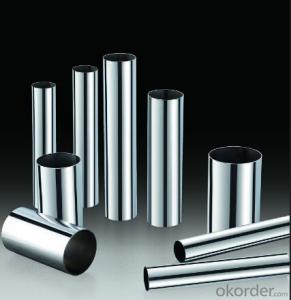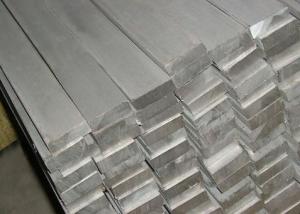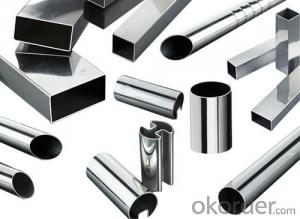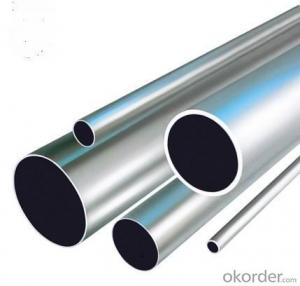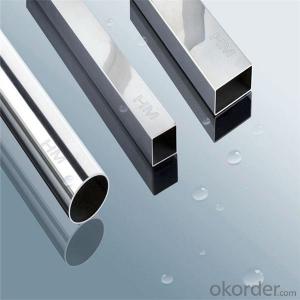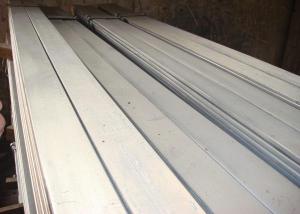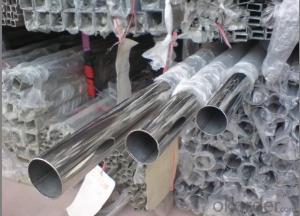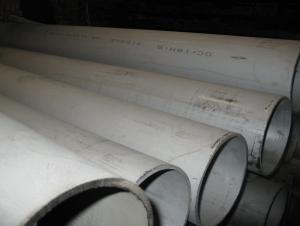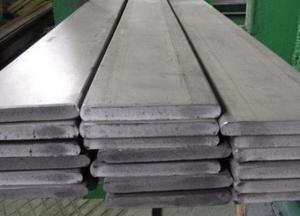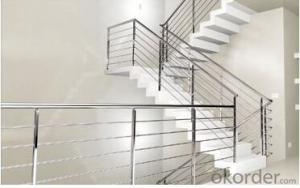STAINLESS STEEL PIPES 201
- Loading Port:
- China Main Port
- Payment Terms:
- TT OR LC
- Min Order Qty:
- -
- Supply Capability:
- -
OKorder Service Pledge
OKorder Financial Service
You Might Also Like
Description:
Stainless Steel Pipe
Material:
304 321 316 310
Packing:
In bundle
MOQ:
5 TONS
Comparison of standardized steels
| EN-standard Steel no. k.h.s DIN | EN-standard Steel name | SAE grade | UNS |
|---|---|---|---|
| 1.4109 | X65CrMo14 | 440A | S44002 |
| 1.4112 | X90CrMoV18 | 440B | S44003 |
| 1.4125 | X105CrMo17 | 440C | S44004 |
| | | 440F | S44020 |
| 1.4016 | X6Cr17 | 430 | S43000 |
| 1.4408 | G-X 6 CrNiMo 18-10 | 316 | |
| 1.4512 | X6CrTi12 | 409 | S40900 |
| | | 410 | S41000 |
| 1.4310 | X10CrNi18-8 | 301 | S30100 |
| 1.4318 | X2CrNiN18-7 | 301LN | |
| 1.4307 | X2CrNi18-9 | 304L | S30403 |
| 1.4306 | X2CrNi19-11 | 304L | S30403 |
| 1.4311 | X2CrNiN18-10 | 304LN | S30453 |
| 1.4301 | X5CrNi18-10 | 304 | S30400 |
| 1.4948 | X6CrNi18-11 | 304H | S30409 |
| 1.4303 | X5CrNi18-12 | 305 | S30500 |
| | X5CrNi30-9 | 312 | |
| 1.4541 | X6CrNiTi18-10 | 321 | S32100 |
| 1.4878 | X12CrNiTi18-9 | 321H | S32109 |
| 1.4404 | X2CrNiMo17-12-2 | 316L | S31603 |
| 1.4401 | X5CrNiMo17-12-2 | 316 | S31600 |
| 1.4406 | X2CrNiMoN17-12-2 | 316LN | S31653 |
| 1.4432 | X2CrNiMo17-12-3 | 316L | S31603 |
| 1.4435 | X2CrNiMo18-14-3 | 316L | S31603 |
| 1.4436 | X3CrNiMo17-13-3 | 316 | S31600 |
| 1.4571 | X6CrNiMoTi17-12-2 | 316Ti | S31635 |
| 1.4429 | X2CrNiMoN17-13-3 | 316LN | S31653 |
| 1.4438 | X2CrNiMo18-15-4 | 317L | S31703 |
| 1.4362 | X2CrNi23-4 | 2304 | S32304 |
| 1.4462 | X2CrNiMoN22-5-3 | 2205 | S31803/S32205 |
| 1.4539 | X1NiCrMoCu25-20-5 | 904L | N08904 |
| 1.4529 | X1NiCrMoCuN25-20-7 | | N08926 |
| 1.4547 | X1CrNiMoCuN20-18-7 | 254SMO | S31254 |
Stainless steel’s resistance to corrosion and staining, low maintenance and familiar lustre make it an ideal material for many applications. There are over 150 grades of stainless steel, of which fifteen are most commonly used. The alloy is milled into coils, sheets, plates, bars, wire, and tubing to be used in cookware, cutlery, household hardware, surgical instruments, major appliances, industrial equipment (for example, in sugar refineries) and as an automotive and aerospace structural alloy and construction material in large buildings. Storage tanks and tankers used to transport orange juice and other food are often made of stainless steel, because of its corrosion resistance. This also influences its use in commercial kitchens and food processing plants, as it can be steam-cleaned and sterilized and does not need paint or other surface finishes.
Stainless steel is used for jewelry and watches with 316L being the type commonly used for such applications. It can be re-finished by any jeweler and will not oxidize or turn black.
Some firearms incorporate stainless steel components as an alternative to blued or parkerized steel. Some handgun models, such as the Smith & Wesson Model 60 and the Colt M1911 pistol, can be made entirely from stainless steel. This gives a high-luster finish similar in appearance to nickel plating. Unlike plating, the finish is not subject to flaking, peeling, wear-off from rubbing (as when repeatedly removed from a holster), or rust when scratched.
Architecture[edit]
Stainless steel is used for buildings for both practical and aesthetic reasons. Stainless steel was in vogue during the art deco period. The most famous example of this is the upper portion of the Chrysler Building (pictured). Some diners and fast-food restaurants use large ornamental panels and stainless fixtures and furniture. Because of the durability of the material, many of these buildings retain their original appearance.
Type 316 stainless is used on the exterior of both the Petronas Twin Towers and the Jin Mao Building, two of the world's tallest skyscrapers.[17]
The Parliament House of Australia in Canberra has a stainless steel flagpole weighing over 220 tonnes (240 short tons).
The aeration building in the Edmonton Composting Facility, the size of 14 hockey rinks, is the largest stainless steel building in North America.
Bridges[edit]
Cala Galdana Bridge in Minorca (Spain) was the first stainless steel road bridge.
Sant Fruitos Pedestrian Bridge (Catalonia, Spain), arch pedestrian bridge.
Padre Arrupe Bridge (Bilbao, Spain) links the Guggenheim museum to the University of Deusto.[18]
Monuments and sculptures[edit]
The Unisphere, constructed as the theme symbol of the 1964-5 World's Fair in New York City, is constructed of Type 304L stainless steel as a sphere with a diameter of 120 feet, or 36.57 meters.
The Gateway Arch (pictured) is clad entirely in stainless steel: 886 tons (804 metric tonnes) of 0.25 in (6.4 mm) plate, #3 finish, type 304 stainless steel.[19]
The United States Air Force Memorial has an austenitic stainless steel structural skin.
The Atomium in Brussels, Belgium was renovated with stainless-steel cladding in a renovation completed in 2006; previously the spheres and tubes of the structure were clad in aluminium.
The Cloud Gate sculpture by Anish Kapoor, in Chicago US.
The Sibelius monument in Helsinki, Finland, is made entirely of stainless steel tubes.
The Man of Steel (sculpture) under construction in Rotherham, England.
Other[edit]
- Automotive bodies
The Allegheny Ludlum Corporation worked with Ford on various concept cars with stainless steel bodies from the 1930s through the 1970s, as demonstrations of the material's potential. The 1957 and 1958 Cadillac Eldorado Brougham had a stainless steel roof. In 1981 and 1982, the DeLorean DMC-12 production automobile used stainless steel body panels over a glass-reinforced plasticmonocoque. Intercity buses made by Motor Coach Industries are partially made of stainless steel. The aft body panel of the Porsche Cayman model (2-door coupe hatchback) is made of stainless steel. It was discovered during early body prototyping that conventional steel could not be formed without cracking (due to the many curves and angles in that automobile). Thus, Porsche was forced to use stainless steel on the Cayman.
- Passenger rail cars
Rail cars have commonly been manufactured using corrugated stainless steel panels (for additional structural strength). This was particularly popular during the 1960s and 1970s, but has since declined. One notable example was the early Pioneer Zephyr. Notable former manufacturers of stainless steel rolling stock included the Budd Company (USA), which has been licensed to Japan's Tokyu Car Corporation, and the Portuguese company Sorefame. Many railcars in the United States are still manufactured with stainless steel, unlike other countries who have shifted away.
- Aircraft
Budd also built an airplane, the Budd BB-1 Pioneer, of stainless steel tube and sheet, which is on display at the Franklin Institute.
The American Fleetwings Sea Birdamphibious aircraft of 1936 was also built using a spot-welded stainless steel hull.
The Bristol Aeroplane Company built the all-stainless steel Bristol 188 high-speed research aircraft, which first flew in 1963.
The use of stainless steel in mainstream aircraft is hindered by its excessive weight compared to other materials, such as aluminum.
- Jewelry
Valadium, a stainless steel and 12% nickel alloy is used to make class and military rings. Valadium is usually silver-toned, but can be electro-charged to give it a gold tone. The gold tone variety is known as Sun-lite Valadium
- Q: Are stainless steel pipes suitable for high-temperature environments?
- Indeed, high-temperature environments are well-suited for stainless steel pipes. Renowned for their remarkable resistance to heat, stainless steel pipes are highly favored for applications in such conditions. They have the ability to endure a broad range of temperatures, from freezing to exceedingly high levels, all while maintaining their mechanical integrity. Consequently, stainless steel pipes prove to be the perfect choice for industries like oil and gas, chemical processing, and power generation, where elevated temperatures prevail. Furthermore, the exceptional corrosion resistance possessed by stainless steel pipes further augments their appropriateness for high-temperature settings.
- Q: Can stainless steel pipes be used for aerospace applications?
- Yes, stainless steel pipes can be used for aerospace applications. Stainless steel is known for its high strength, durability, and resistance to corrosion, making it an ideal material for various aerospace components. Stainless steel pipes are commonly used in aerospace applications for fuel and hydraulic systems, as well as for structural support and exhaust systems. The high strength-to-weight ratio of stainless steel allows for lighter and more fuel-efficient aircraft designs. Additionally, stainless steel's resistance to high temperatures and extreme conditions makes it suitable for aerospace applications where performance and reliability are crucial.
- Q: What is the difference between SCH and XS stainless steel pipes?
- SCH and XS are both schedules used to classify stainless steel pipes based on their wall thickness. However, the main difference lies in the wall thickness itself. SCH stands for Schedule and is a numerical representation indicating the pipe's wall thickness, while XS stands for Extra Strong and represents pipes with a thicker wall compared to SCH pipes.
- Q: What is the difference between Type 304L and Type 316L stainless steel pipes?
- Type 304L and Type 316L stainless steel pipes are both popular choices for various applications due to their corrosion-resistant properties. However, they differ in their composition and performance in specific environments. The main difference lies in their alloy content. Type 304L stainless steel contains 18-20% chromium and 8-12% nickel, while Type 316L stainless steel contains 16-18% chromium, 10-14% nickel, and 2-3% molybdenum. The addition of molybdenum in Type 316L enhances its resistance to corrosion, particularly in chloride-rich environments. This makes Type 316L more suitable for applications where the pipes will be exposed to seawater, brine, or other aggressive chemicals. Another distinguishing factor is their mechanical properties. Type 316L stainless steel has slightly higher tensile strength and yield strength compared to Type 304L. It also exhibits better creep and stress rupture properties, making it more suitable for high-temperature applications. However, Type 304L is still a good choice for most general-purpose applications and offers excellent durability and longevity. In terms of cost, Type 316L stainless steel pipes are generally more expensive than Type 304L due to the added alloying elements. Therefore, the choice between the two will depend on the specific requirements of the application, considering factors such as the corrosive environment, temperature, and budget. Overall, while both Type 304L and Type 316L stainless steel pipes offer excellent corrosion resistance, Type 316L provides superior performance in more aggressive environments and higher temperatures. It is important to consult with a materials expert or engineer to determine the most suitable stainless steel pipe for a specific application.
- Q: Is stainless steel flexible enough for plumbing applications?
- Yes, stainless steel is flexible enough for plumbing applications. It can be easily bent and shaped to fit the required plumbing configurations, making it a versatile and commonly used material in the plumbing industry.
- Q: Can stainless steel pipes be used for oil and gas applications?
- Indeed, oil and gas applications can benefit from the utilization of stainless steel pipes. Due to its remarkable resistance to corrosion and capability to endure extreme temperatures and pressures, stainless steel emerges as an optimal substance for the conveyance and preservation of oil and gas. Moreover, these pipes exhibit exceptional mechanical qualities, encompassing elevated tensile strength and fortitude, guaranteeing their longevity and dependability within rigorous oil and gas surroundings. Consequently, stainless steel pipes find widespread employment across diverse sectors of the oil and gas industry, encompassing drilling, production, refining, and transportation of oil and gas commodities.
- Q: Are stainless steel pipes resistant to scaling and oxidation?
- Stainless steel pipes possess exceptional resistance against scaling and oxidation due to the presence of a protective chromium oxide layer on their surface. This layer acts as a barrier, shielding the underlying metal from oxygen and other elements that can lead to scaling and oxidation. Consequently, stainless steel pipes are capable of enduring high temperatures, corrosive surroundings, and frequent contact with water without any deterioration or rusting. Hence, they are an ideal option for numerous applications in industries like construction, chemical, and food processing, where the ability to resist scaling and oxidation is paramount.
- Q: How do you protect stainless steel pipes from heat damage?
- To protect stainless steel pipes from heat damage, it is important to insulate them with materials that have high thermal resistance. This can be done by using insulation wraps, jackets, or sleeves made from materials like fiberglass, mineral wool, or ceramic fiber. Additionally, ensuring proper ventilation and maintaining a safe distance from heat sources can further minimize the risk of heat damage to stainless steel pipes.
- Q: What is the composition of stainless steel pipes?
- Stainless steel pipes are primarily composed of iron with a minimum of 10.5% chromium content by mass. The addition of chromium creates a protective oxide layer on the surface, known as the passive layer, which helps prevent corrosion and provides stainless steel with its characteristic resistance to rust and staining. Additionally, stainless steel pipes may contain other elements such as nickel, molybdenum, and manganese, which enhance their mechanical properties and corrosion resistance. These alloying elements contribute to the overall strength, durability, and versatility of stainless steel pipes, making them suitable for various applications in industries such as construction, automotive, and manufacturing.
- Q: What is the difference between 17-7 and 15-7 stainless steel pipes?
- The main difference between 17-7 and 15-7 stainless steel pipes lies in their composition and properties. 17-7 stainless steel is a precipitation-hardening stainless steel that contains about 17% chromium and 7% nickel. It also includes aluminum, which enables it to be heat treated to achieve high strength and hardness. This type of stainless steel is known for its excellent corrosion resistance, good formability, and high strength. It is often used in applications that require high strength and good corrosion resistance, such as aerospace components, springs, and chemical processing equipment. On the other hand, 15-7 stainless steel is a semi-austenitic precipitation-hardening stainless steel that contains about 15% chromium and 7% nickel. It also includes 2% molybdenum, which enhances its corrosion resistance. This grade of stainless steel offers good mechanical properties, high strength, and excellent corrosion resistance. It is commonly used in applications that require high strength, good formability, and resistance to stress corrosion cracking, such as springs, washers, and medical devices. In summary, while both 17-7 and 15-7 stainless steel pipes offer excellent corrosion resistance and high strength, the difference lies in their composition and specific properties. 17-7 stainless steel contains aluminum for enhanced heat treatability, while 15-7 stainless steel includes molybdenum for improved corrosion resistance. The choice between these two grades depends on the specific requirements of the application, such as strength, formability, and resistance to corrosion or stress corrosion cracking.
Send your message to us
STAINLESS STEEL PIPES 201
- Loading Port:
- China Main Port
- Payment Terms:
- TT OR LC
- Min Order Qty:
- -
- Supply Capability:
- -
OKorder Service Pledge
OKorder Financial Service
Similar products
Hot products
Hot Searches
Related keywords

